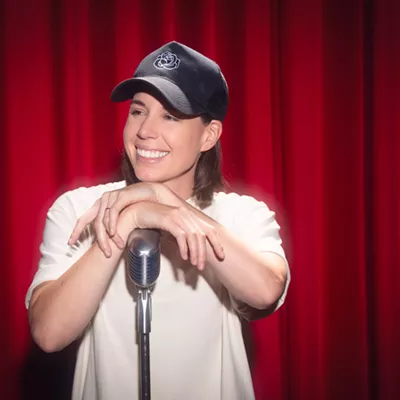These memories come hurtling back to me as I walk into the Museum of Contemporary Art's current show, simply titled, Drawn. Anne-Marie Russell, the museum's director, says there's a reason I was reminded of that distinction.
"Drawing is a fundamental way in which we understand the world around us. It's a common practice for all artists. But in reality, everybody draws."
That's one reason she's installed the work of dozens of Tucson artists and a handful from Phoenix and New York. For the viewer, Russell has other hopes.
"For those of us who aren't artists, this is a way to comprehend the mystery of art making. But I also want people to see drawing in a wider conceptual sense--to see how drawing is different for different artists."
So, we sat down with two of the 32 artists in the show to find out what role drawing holds for them.
Peter Happel Christian seems to have crawled out from the 19th century with his Familiar Ground: Front Yard Topography, a series of 20 letter-sized, framed drawings, minimally depicting the rocks in his Tucson front yard, replete with color tabs delineating their cardinal direction in the landscape.
"I decided to map my front yard, because it was so foreign to anything I'd ever experienced," says Christian, who grew up in Iowa and lived most recently in Oregon.
"I didn't have access to photo materials when I first moved here this summer, so I drew the rocks in my yard, thinking it'd be a way to understand this new place."
He adds, "My neighbor caught me with a flashlight, down on my hands and knees and asked what I was doing. I explained, 'I'm drawing rocks.' He said, 'No really, what are you doing?'"
This combination of scientific map-making and nature drawing results in a beautiful but strange work. When viewed from far away, it looks like a bunch of framed, blank pages with small color tabs on them.
"By themselves, they're a meditative look at a couple of rocks. As a collection, it's an alternative view of my yard. When I go out to get my mail, I have a better sense of where the mailbox is. I've surveyed the area," Christian offers.
His mapping is a theme that runs throughout Drawn. Rachel Rossner's Refugee Suit--textbook-like images drawn on black paper--depict apparel that would suffice in the event you were about to get booted out of your country.
"I make images mainly for proposals of grandiose projects that I'll never complete. Drawing is the easiest way for me to present these projects," says Rossner of her sketches, diagrams and map-like images.
She adds, "The refugee suits obsessed me from childhood. Wouldn't it be great if you already had the clothes with the money sewn into the sleeves? This obsession probably came from all those Holocaust films I saw as a child. But I also spent three years in Bosnia as an adult. So this work came out of my observations of other's experiences. I had no intention of filling in the gaps."
Instead, Rossner is drawn to the sparseness of drawing.
"You can understand that you're looking at a poetic idea. The way drawing can create an illusion is what compels me."
The idea that other media, like painting or photography, fill in too many details is a driving force for the show, explains Anne-Marie Russell.
"What's the smallest piece of visual information that conveys meaning? That's the magic that gets hidden in painting or photography. But it's revealed in drawing. One of my favorite institutions of contemporary art is the Drawing Center in New York. It's based on a process, a practice."
Much of the work in Drawn defies strict classification of what a drawing should be, in favor of work that possesses the quality of drawing.
"I'm a big fan of silly. Drawing is the place you get away with things. Any gesture, in fact, is a drawing," adds Russell.
Several artists in the show have made such gestures. Coke Wisdom O'Neal's Songs That Make Me Cry is a nearly unbearable meditation on masculinity and the syrupy music that gets us through hard times. Instead of a typical sketch on paper, O'Neal has chosen a video close-up for his self-portrait, making this "drawing" even more alluring. Jennifer Guerin's work is also a self-portrait, though the palette is a mattress, quilted and framed, with bits of hair and embroidery that seductively reveal notions of love and sex. And Harmony Hammond's work blurs the lines between genres even more by drawing with blood.
Anne-Marie Russell pinpoints the common theme of the artists in this show.
"The first thing is the accessibility of the work that you couldn't get with painting. So, at the party, anyone could walk out the door with something under their arm. And don't forget to add your own drawing on our interactive wall canvas. Be inspired."
A holiday party and sale benefits MOCA's Exhibition Fund and closes Drawn on Thursday, Dec. 18. Drawings go for as low as $5. Tamales and beer are available from 7 to 9 p.m. Live music with Nowhere Man starts at 9 p.m. Admission to the party costs $15, or $10 for MOCA members. Five bucks gets you in for the band only.
The Museum of Contemporary Art is located at 191 E. Toole Ave. Gallery hours are noon to 6 p.m. Tuesday through Saturday. Call 624-5019 for details.







